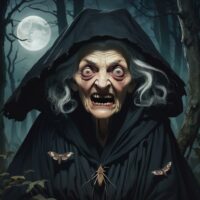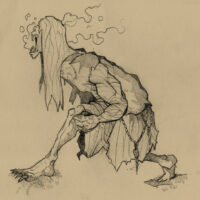Shtriga : The Vampiric Witch
Listen
At a glance
| Description | |
|---|---|
| Origin | Albanian Mythology |
| Classification | Spirits |
| Family Members | N/A |
| Region | Albania |
| Associated With | Blood sucking, Evil, Child Abduction |
Shtriga
Introduction
In the shadowy world of Albanian mythology, one of the most chilling figures is the Shtriga, a vampiric witch feared for her nocturnal hunger and sinister powers. She is no ordinary witch but a supernatural predator who feeds on human vitality, particularly that of children. Her legend has survived centuries of oral tradition, reflecting the fears and beliefs of a society that explained misfortune, illness, and unexplained deaths through the presence of such beings. Rooted in pre-Christian folklore, the Shtriga remains one of the most terrifying and fascinating characters in Balkan mythology, blending superstition with cultural warnings about envy, isolation, and misfortune.
Physical Traits
The Shtriga is usually imagined as a woman with unsettling features that set her apart from ordinary mortals. Often depicted as middle-aged or elderly, she carries the stigma of being visibly different and socially outcast. Her face is said to be gaunt or distorted, and her pale-colored eyes—ranging from grey to icy blue—were traditionally seen as a mark of danger. In Albanian, this trait is tied to the concept of the evil eye, where a mere glance could bring misfortune.
One of the Shtriga’s most frightening attributes is her ability to shift form. At night, she abandons her human appearance and transforms into small winged insects such as moths, bees, or flies. This ability allowed her to enter homes unnoticed, creeping into the beds of sleeping infants or weak adults. By blending into the natural world, she became almost impossible to detect, a reminder that danger could be lurking in the smallest, most ordinary things.
Family
Unlike many mythological beings who are linked to divine or heroic bloodlines, the Shtriga’s origins are grounded in the human world. In folklore, she is not born into a family of monsters but becomes what she is through circumstances of misfortune or spiritual corruption. Stories suggest that women who were childless, widowed, or socially marginalized were often accused of being Shtriga. These suspicions reflected deep-seated fears around fertility, lineage, and the social role of women.
One folktale even refers to her as the grandmother of all witches, a figure dwelling in the Underworld who commands respect and fear within a supernatural hierarchy. This portrayal positions her as a primordial matriarch, the root of witchcraft itself, shaping a narrative where she embodies both fear of the outsider and awe for her mysterious power. Though she lacks a conventional family in the mortal sense, her influence is woven into the fabric of human families, often blamed for curses, infertility, and generational misfortune.
Other names
The name Shtriga comes from the Albanian word shtrigë, which in its definite form becomes shtriga. Its roots trace back to the Latin strīga, meaning “witch” or “evil spirit,” linking her to a broader European tradition of vampiric beings. Similar figures exist across cultures: the Italian strega, the Romanian strigă, and the Polish strzyga all share etymological and thematic connections. These parallels reveal a shared cultural anxiety across Europe about witches, vampires, and the supernatural female.
Within Albania, the Shtriga is sometimes referred to simply as a soul-draining witch, while in Istrian folklore, the related strige were believed not only to harm but also to heal. This dual identity—both destroyer and healer—highlights her complex role in folklore. In certain Albanian dialects outside the homeland, such as those spoken in Ukraine, there was no single word to describe her kind; instead, phrases like unclean spirit were used, underscoring her role as an outsider to the human order.
Powers and Abilities
The Shtriga’s powers are a blend of vampirism and witchcraft, making her one of the most feared supernatural beings in Albanian tradition. Her primary ability lies in draining life force, often by sucking the blood of sleeping infants. This act left the victims pale, sickly, and often on the verge of death, providing a folk explanation for sudden illness or child mortality. Yet, paradoxically, it was said that only the Shtriga herself could reverse the harm she caused. By spitting the blood back into her victim’s mouth, she could restore life, suggesting a duality of destructive and restorative power.
Her shapeshifting into insects gave her mobility and secrecy, allowing her to move undetected through the night. She was also associated with curses and the evil eye, capable of inflicting disease and misfortune simply through her gaze. Protection against her was deeply embedded in Albanian folk practices. Garlic, salt, and ritual incantations were commonly used defenses, and some traditions involved secret chants meant to repel her. This constant need for protection highlights how real the threat of the Shtriga felt in the daily lives of villagers who lived under her shadow.
Modern Day Influence
Although belief in the Shtriga has faded with the decline of traditional superstition, her presence endures in modern culture. She has become a symbol of Albanian folklore, appearing in literature, ethnographic studies, and popular discussions of myth. Her reputation as a soul-sucking witch even crossed into global media, most notably in the television series Supernatural, where she was portrayed as a child-hunting demon. This adaptation introduced her to a wider audience, blending Albanian tradition with Western horror storytelling.
In Albania itself, the Shtriga still surfaces in conversations about folklore and cultural heritage. She embodies the darker aspects of the past—times when fear of witches and the unexplained guided social behavior. Folklore festivals and cultural exhibitions occasionally revisit her myth, reminding modern audiences of the stories that once shaped daily life. Beyond Albania, scholars draw connections between the Shtriga and other European vampiric beings, situating her within a wider network of mythological comparisons.
What makes the Shtriga particularly enduring is her adaptability. While rooted in traditional fears of infertility, disease, and envy, she continues to evolve in modern retellings as a symbol of hidden danger and societal unease. Whether depicted as a monstrous witch or a tragic figure born of isolation, the Shtriga remains a potent reminder of how mythology speaks to both ancient fears and contemporary imagination.
Related Images
Source
Durham, E. (1909). High Albania. Edward Arnold.
Horror Chronicles. (2024, June 16). Shtriga: The Albanian and Kosovar Vampire Witch. Retrieved from https://horrorchronicles.com/shtriga/
Mythical Encyclopedia. (n.d.). Shtriga: Mythical Creatures. Retrieved from https://mythicalencyclopedia.com/shtriga/
Wikipedia contributors. (n.d.). Shtriga. In Wikipedia. Retrieved September 4, 2025, from https://en.wikipedia.org/wiki/Shtriga
Mojosiedlak, M. (n.d.). The Enigma of the Shtriga: Legends and Lore. Retrieved from https://mojosiedlak.com/the-enigma-of-the-shtriga-legends-and-lore/
Frequently Asked Questions
What is lorem Ipsum?
I am text block. Click edit button to change this text. Lorem ipsum dolor sit amet, consectetur adipiscing elit. Ut elit tellus, luctus nec ullamcorper mattis, pulvinar dapibus leo.
What is lorem Ipsum?
I am text block. Click edit button to change this text. Lorem ipsum dolor sit amet, consectetur adipiscing elit. Ut elit tellus, luctus nec ullamcorper mattis, pulvinar dapibus leo.
What is lorem Ipsum?
I am text block. Click edit button to change this text. Lorem ipsum dolor sit amet, consectetur adipiscing elit. Ut elit tellus, luctus nec ullamcorper mattis, pulvinar dapibus leo.
What is lorem Ipsum?
I am text block. Click edit button to change this text. Lorem ipsum dolor sit amet, consectetur adipiscing elit. Ut elit tellus, luctus nec ullamcorper mattis, pulvinar dapibus leo.
What is lorem Ipsum?
I am text block. Click edit button to change this text. Lorem ipsum dolor sit amet, consectetur adipiscing elit. Ut elit tellus, luctus nec ullamcorper mattis, pulvinar dapibus leo.








